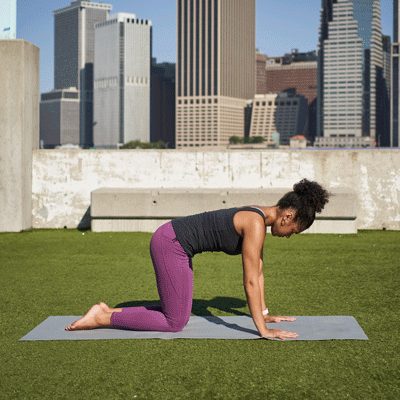Making small changes to how you exercise may help limit flares of eczema. Activities such as yoga, walking, and swimming can be adapted for people with this condition.
Eczema is a condition that involves inflammation in your skin, which causes symptoms such as skin irritation, dryness, and itchiness. Atopic dermatitis is a common type of eczema.
Exercising regularly is important for supporting your mental and physical well-being when you live with eczema. Exercise may help reduce stress; a common trigger that can make your eczema symptoms worse.
A
Exercise also carries some risks, which can be managed. It may cause overheating or sweating, which may trigger a flare-up of your eczema symptoms. Exposure to cold, dry air, or wind during exercise may also dry out your skin and make your eczema symptoms worse.
Here are some general tips to help manage these risks and protect your skin during exercise:
- Apply moisturizer to your skin before and after exercising.
- Exercise in comfortably cool and well-ventilated areas.
- Wear clean, loose, breathable clothing while exercising.
- Take regular breaks during workouts to cool down and blot off sweat.
- Wear sunscreen and sun-protective clothing when exercising outdoors.
- Drink water or other hydrating fluids before, during, and after exercising.
- Change out of sweaty clothes and rinse your skin with cool or lukewarm water right after exercising.
Adjusting how you perform certain types of exercise may also help protect your skin and reduce your risk of flare-ups.
Here are some examples of stress-relieving exercises that you can adapt for eczema.
Yoga is a meditative mind-body practice that combines mental focus with controlled breathing and movement to relieve stress and support physical and mental well-being.
You can attend a yoga class or follow an instructional video at home to learn yoga movements.
One example of a stress-relieving yoga pose is Chakravakasana, also called the Cat-Cow Pose. Here’s how to do it:
- Start by kneeling on your hands and knees on a clean floor, nonslip rug, or yoga mat. Position your hands under your shoulders and your knees under your hips, with your spine in a neutral position.
- Slowly inhale while you arch your spine so your head and tailbone lift toward the ceiling. Allow your stomach to drop toward the floor. This is the Cow Pose.
- Slowly exhale while you curve your spine so your head and tailbone drop toward the floor. Pull your stomach up toward the ceiling. This is the Cat Pose.
- Repeat multiple times.
Many yoga practitioners wear tight leggings or other synthetic clothing, which may irritate your skin. Instead, consider wearing looser clothing made from breathable material, such as cotton.
Consider avoiding Bikram yoga and other forms of hot yoga, which are performed in a heated room. These types of yoga promote excessive sweating. Instead, try to do yoga in a comfortably cool and well-ventilated area.
Walking is a low impact exercise that can help relieve stress, boost mood, and support heart health, according to a 2023 review.
Walking indoors in a comfortably cool and well-ventilated area may help prevent overheating and limit sweating, especially during warm weather. Options include:
- walking on a treadmill in a home gym or fitness center
- walking on an indoor track at a community center or fitness center
- walking around a mall, shopping center, or other large indoor space
If you prefer to walk outdoors:
- Check the weather forecast beforehand and try to limit long walks in extreme temperatures. The early morning and evening are often cooler than midday.
- Check the air quality index beforehand and try to avoid walking at times or in areas where mold, pollen, or air pollution levels are high if these are eczema triggers for you.
- Consider choosing a well-shaded path with benches or rest areas where you can take breaks along the way.
You might also find it helpful to try walking meditation, which combines walking with mindful focus to help relieve stress. As you walk, focus your attention on the sensations and movements that your body experiences:
- How does the ground below your feet feel as you take each step?
- How do the different parts of your feet and legs move as you walk?
- How do your arms hang or move?
- How does your head feel balanced on your neck and shoulders?
- How does your breath feel as it moves in and out of your body?
- What do you see, hear, and smell around you?
You can perform this meditation while walking indoors or outdoors.
Cycling regularly may help lower the risk of heart disease and type 1 diabetes, support weight management, and ease stress, according to a 2023 review.
Cycling on a stationary bike in a home gym or fitness center makes it easy to adjust your pace and resistance level. If you find yourself overheating or sweating, consider slowing down or lowering the resistance level. Choosing a cool room to cycle in, adjusting the thermostat, or positioning a fan near your bike can also help you stay cool.
If you prefer to cycle outdoors:
- Schedule bike rides for times or days when the temperature is comfortably cool.
- Avoid cycling in areas where mold, pollen, or air pollution levels are high if these are triggers for you.
- Choose a flat shaded bike path if you get overheated or sweaty while cycling uphill or in the sun.
- Wrap a soft piece of cotton, silk, or bamboo fabric around your bike helmet strap if it irritates your skin.
Take regular breaks to rest, cool down, and sip on hydrating fluids while biking indoors or outdoors. You might also find it helpful to splash or spray cool water on your face or body or press a cool damp towel against your skin when you feel overheated or sweaty.
Thanks to water’s cooling effects, swimming can give you a full-body workout without leaving you hot and sweaty. This may be beneficial for limiting eczema flare-ups.
Is swimming in a chlorinated pool a good choice for you? How about a saltwater pool or an open body of water, like an ocean or lake? The best venue for swimming depends on how your skin reacts to different chemicals.
Properly chlorinated pool water has antimicrobial properties similar to those of a dilute bleach bath. This may help reduce eczema symptoms in some people. On the other hand, pool water often includes calcium chloride, which may damage the skin barrier and increase dryness or irritation.
More research is needed to learn how seawater or saltwater pools affect people with eczema. You might find that swimming in seawater or saltwater pools soothes your skin or irritates it.
Pay attention to how your skin feels after swimming in different pools, lakes, oceans, or other bodies of water. Consider avoiding venues that seem to trigger symptoms.
Here are other ways you can protect your skin while swimming:
- Apply an emollient ointment or cream to your skin before swimming.
- Choose water that’s comfortably cool rather than very warm or very cold to swim in. Avoid soaking in hot tubs or taking hot baths or showers before or after you swim.
- Avoid goggles, swim caps, swimsuits, and other swimwear that contain materials that may trigger an eczema flare. For example, some people find that rubber or latex triggers eczema flares and prefer goggles or swim caps made from silicone.
- Use a clean towel and avoid sharing towels with other people to lower your risk of bacterial skin infections.
- Immediately remove your swimwear after swimming and rinse it well to remove chlorine.
- Immediately rinse your skin with lukewarm or cool unchlorinated water after swimming, gently pat it try, and apply an emollient moisturizer.
If you plan to swim outdoors, apply sunscreen before you head outside. Also, check for water quality notices and try to avoid swimming in lakes or other bodies of water with high levels of bacteria. Exposure to certain bacteria may cause skin infections.
Consider avoiding swimming if you have a severe eczema flare or a skin infection.
Weightlifting is a form of resistance training that strengthens your muscles and bones and may also provide mental health benefits, reports a 2024 review.
You can perform weightlifting exercises using weight machines or free weights, such as dumbbells or barbells.
Try to perform a variety of weightlifting exercises to target every major muscle group in your body.
For example, the squat to overhead press is a compound exercise that targets multiple muscles in your lower and upper body. Here’s how to do it:
- Start by standing upright, with your feet shoulder-width apart, your elbows bent, and dumbbells held at shoulder height.
- Slowly bend your knees and push your hips back into a squat position while keeping your back flat and your core braced.
- Slowly push up through your heels, straighten your legs to stand, and press the dumbbells up over your head.
- Slowly lower the dumbbells down to shoulder height.
- Repeat 1 to 3 sets of 8 to 12 repetitions.
Take breaks between each set of weightlifting exercises to cool down. Sip water or other fluids to stay hydrated. Consider keeping a cool wet towel nearby to blot your face or body when you feel overheated or sweaty.
Wipe down free weights or weight machines before you use them, especially if you share the equipment with others. This may help reduce the presence of sweat and bacteria that can cause skin infections.
Your fitness center may provide cleaning products to wipe down equipment, but those products might contain irritating ingredients. You may bring your own eczema-friendly cleaning products to use instead. You can search for eczema-friendly cleaning products using the National Eczema Association’s Eczema Product Directory.
Regular exercise is important for supporting your physical and mental health.
It may help reduce stress, which is a common eczema trigger. It may also help protect against depression, anxiety, and other mental health challenges that are more common than average in people with eczema.
Overheating or sweating during exercise may cause eczema symptoms to get worse. Drinking plenty of fluids, exercising in a cool and well-ventilated area, and taking regular breaks to rest and cool down may help.
Applying moisturizer before and after exercising, wearing loose breathable clothing, and showering or bathing after workouts may also help protect your skin from exercise-related triggers.
It’s also important to wash your workout wear to help remove sweat and bacteria.
Talk with your doctor to learn more about the potential benefits and risks of different types of exercise. They can help you learn which types of exercise may be more or less likely to cause a flare of your eczema symptoms. They can also share strategies for preventing and managing flares while working out.





